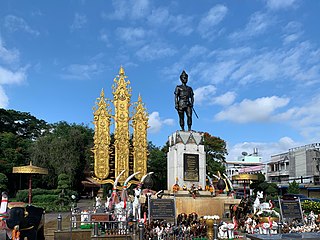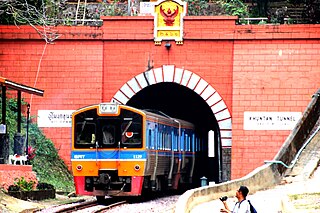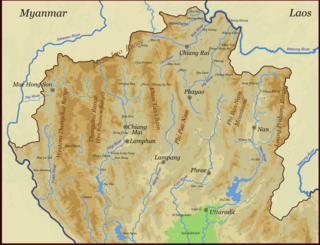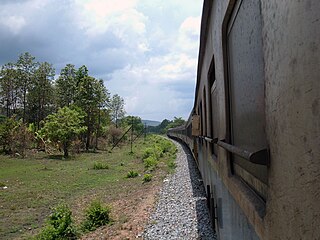
Chiang Rai is the northernmost major city in Thailand, with a population of about 200,000 people. It is located in Mueang Chiang Rai District, Chiang Rai Province. Chiang Rai was established as a capital city in the reign of King Mangrai, in 1262 CE.

Chiang Rai is one of Thailand's seventy-six provinces, which lies in upper northern Thailand and is Thailand's northernmost province. It is bordered by the Shan State of Myanmar to the north, Bokeo province of Laos to the east, Phayao to the south, Lampang to the southwest, and Chiang Mai to the west. The provinces is linked to Houayxay Laos by the Fourth Thai–Lao Friendship Bridge that spans the Mekong.

Chiang Mai is the second largest Province (changwat) of Thailand. It lies in upper northern Thailand and has a population of 1.78 million people. It is bordered by Chiang Rai to the northeast, Lampang and Lamphun to the south, Tak to the southwest, Mae Hong Son to the west, and Shan State of Burma to the north. The capital, Chiang Mai, is 685 kilometres (426 mi) north of Bangkok.

Lampang is one of Thailand's seventy-six provinces (changwat), lies in upper northern Thailand. The old name of Lampang was Khelang Nakhon.

Lamphun is one of Thailand's seventy-six provinces (changwat), and lies in upper northern Thailand. Neighboring provinces are Chiang Mai, Lampang, and Tak.

Northern Thailand, or more specifically Lanna, is geographically characterised by several mountain ranges, which continue from the Shan Hills in bordering Myanmar to Laos, and the river valleys that cut through them. Like most of Thailand, it has a tropical savanna climate, but its relatively high elevation and latitude contribute to more pronounced seasonal temperature variation, with cooler winters than the other regions.

Lampang, also called Nakhon Lampang to differentiate from Lampang province, is the third largest city in northern Thailand and capital of Lampang province and the Mueang Lampang district. Traditional names for Lampang include Wiang Lakon and Khelang Nakhon. The city is a trading and transportation center. Lampang lies 601 km (373 mi) north of Bangkok and 101 km (63 mi) southeast of Chiang Mai.

The State Railway of Thailand (SRT) is the state-owned rail operator under the jurisdiction of the Ministry of Transport in Thailand.

The Thai highlands or Hills of northern Thailand is a mountainous natural region in the north of Thailand. Its mountain ranges are part of the system of hills extending through Laos, Burma, and China and linking to the Himalayas, of which they may be considered foothills.

Khun Tan is a district (amphoe) of Chiang Rai province, northern Thailand.

Rail transport plays a crucial role in connecting various regions of Thailand, transporting both goods and passengers through a range of transportation options that include inter-city and commuter rail, mass rapid transit, monorails, and airport rail links. The State Railway of Thailand (SRT) operates a network of intercity railways spanning 4,845.1 kilometers, covering 47 provinces across the country. SRT is committed to developing railway lands through its subsidiary, SRT Asset (SRTA), which focuses on transit-oriented development (TOD) initiatives. The Krung Thep Aphiwat Central Terminal in Bangkok serves as the primary transportation hub for rail transport in Thailand, connecting various types of rail transportation throughout the country. It covers an area of 274,192 square meters, making it the largest railway station in Southeast Asia, and is situated in a new central business district (CBD) that is currently being developed.

The Khun Tan Range is a mountain range that occupies a central position in Northern Thailand. Most of the range is located in Chiang Mai, western Chiang Rai, Lampang and Lamphun Provinces.

The Northern Line is a railway line in Thailand, running between the capital Bangkok and the northern city of Chiang Mai. It is the second longest railway line in Thailand at 751 kilometres (467 mi) long, has 130 operational stations and halts, and is operated by the State Railway of Thailand. The line first opened in 1896. Major cities served by the line include Bangkok, Ayutthaya, Nakhon Sawan, Phitsanulok, Lampang, and Chiang Mai.

Chiang Mai Main Line is a main line of the Northern Line operated by State Railway of Thailand that connects between Hua Lamphong railway station in the central and Chiang Mai railway station in the north, passing through many provinces. It is the second longest railway line in Thailand, after Su-ngai Kolok Main Line. Notable services include the Nakhon Phing Express, the first class train serving the line. Many accidents have occurred on the line in recent years, prompting renovation work to commence on the track in late 2013, finally reopening on 2 December 2013.

Khun Chae National Park is a national park in Chiang Rai Province, Thailand. This rugged park is home to high mountains and waterfalls.

Khun Tan railway station is a railway station on the Northern Line located in Lamphun Province, Thailand. It is operated by the State Railway of Thailand, and is 683.14 km (424.5 mi) from Bangkok railway station. Khun Tan Railway Station is in the Tha Pladuk Subdistrict, Mae Tha District.
Mae Tan Noi railway station is a railway station located in Wiang Tan Subdistrict, Hang Chat District, Lampang. It is a class 3 railway station located 671.808 km (417.4 mi) from Bangkok railway station. Between Khun Tan and Mae Tan Noi, the railway crosses 3 bridges: Composite, Sam Ho and Song Ho bridges, then the Khun Tan Tunnel before arriving at Khun Tan station.
Khun Chang Khian is a village administered as Moo 4 in Chang Phueak tambon (subdistrict) of Mueang Chiang Mai District, in Chiang Mai province, Thailand. In 1999, it had a total population of 697 people. It is a White Hmong village that was founded in 1955. The village is located to the east of Doi Pui and is approximately 1,350 metres (4,430 ft) above sea level.

Pang Tup Khop Tunnel is a railway tunnel of Thailand on the northern route. Considered another railway tunnel of northern Thailand besides the famed Khun Tan Tunnel.

















